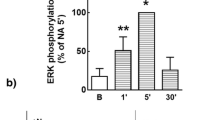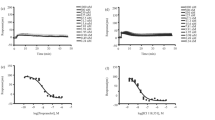Summary
-
1.
Using [3H]DHA and unlabeledl-alprenolol, a substantial amount of over 64% specific binding ofβ-adrenergic receptor has been identified on the neuroblastoma × glioma hybrid NG108-15 cell, which has been proven to display numerous functional characteristics of intact neurons.
-
2.
Beta-adrenergic receptor binding on intact NG108-15 cells does not change significantly upon morphological differentiation, induced by 1 mM dibutyryl cyclic AMP (dBcAMP).
-
3.
The [3H]DHA binding on intact NG108-15 cells is rapid, saturable, and reversible, having at 1/2 of 1.0 min for association and 3.5 min for dissociation.
-
4.
The affinity constant (K d) and maximum binding capacity (B max) for binding of [3H]DHA toβ-adrenergic receptors on NG108-15 cells have been estimated by Scatchard plot analysis to be 2.5 and 0.23 nM, respectively. Further analysis indicates a single class of receptors for [3HDHA binding on NG108-15 cells.
-
5.
Studies on kinetic properties have revealed on-rate (K + 1) and off-rate (K - 1) constants of 0.7 × 10−9 M min−1 and 0.19 min−1, respectively. Further, the IC50 value and inhibition constant (K i) for unlabeledl-alprenolol to inhibit [3HDHA binding on NG108-15 cells have been estimated to be 10−5 and 8.9 × 10−6 M, respectively.
-
6.
The rank-order potency of catecholamine agonists, (−)ISO > (+)ISO > EPI > NE, reveals the presence of type 2 receptor for theβ-adrenergic binding on both differentiated and undifferentiated NG108-15 cells.
-
7.
The present study indicates that the clonal neuroblastoma × glioma hydbrid NG108-15 cell line possesses substantial amounts ofβ-adrenergic receptors with characteristics similar to those on neuronal cells.
Similar content being viewed by others
References
Alexander, R. W., Davis, J. N., and Lefkowitz, R. J. (1975). Direct indentification and characterization of beta-adrenergic receptors in rat brain.Nature 258437–440.
Cheng, Y. C., and Prusoff, W. H. (1973). Relationship between the inhibition constant (Ki) and the concentration of inhibitor which causes 50% inhibition (IC50) of an enzymatic reaction.Biochem. Pharmacol. 223099–3108.
Galand, S. P., and Allred, S. (1981). Binding and functional characteristics of beta-adrenergic receptors in the intact neutrophil.J. Lab. Clin. Med. 98227–237.
Ghahary, A., and Cheng, K. W. (1989). Characterization of muscarinic acetylcholine receptors on intact neuroblastoma × glioma NG108-15 cells upon induced differentiation.Mol. Cell. Biochem. 86181–188.
Ghahary, A., Vriend, J., and Cheng, K. W. (1989). Modification of the indolamine content in neuroblastoma × glioma hybrid NG108-15 cells upon induced differentiation.Cell. Mol. Neurobiol. 9343–355.
Hamprecht, B. (1977). Structure, electrophysiological, biochemical and pharamacological properties of neuroblastoma × glioma hybrids in cell culture.Int. Rev. Cytol. 4990–170.
Hamprecht, B., and Schultz, J. (1973). Influence of noradrenalin, prostaglandin El and inhibitors of phophodiesterase activity on the levels of the cyclic adenosine 3,5,-monophosphate in somatic cells hybrids.Physiol. Chem. 3541635–1641.
Hill, A. V. (1910). The possible effects of the aggregation of the molecules of hemoglobin on its dissociation curve.J. Physiol. 40iv-vii.
Insel, P. A., and Stoolman, L. M. (1978). Radioligand binding to beta adrenergic receptors of intact cultured S49 cells.Mol. Pharmacol. 14549–561.
Insel, P. A., Mahan, L. C., Motulsky, H. V., Stoolman, L. M., and Koachman, A. M. (1983). Time-dependent decreases in binding affinity of agonists forβ-adrenergic receptors of intact S49 lymphoma cells.J. Biol. Chem. 25813597–13605.
Kahn, D. J., Mitrius, J. C., and U'Prichard, D. C. (1981). Alpha-adrenergic receptors in neuroblastoma × glioma hybrid cells: Characterization with agonist and antagonist radioligands and relationship to adenylate cyclase.Mol. Pharmacol. 2117–26.
Klee, W., and Nirenberg, M. (1974). Neuroblastoma × glioma hybrid cell line with morphine receptors.Proc. Natl. Acad. Sci. USA 713474–3477.
Lands, A. M., Arnold, A., McAuliff, J. P., Luduena, F. P., and Brown, J. G., Jr. (1967). Differentiation of receptor systems activated by sympathomimetic amines.Nature 214597–598.
Maderspach, L., and Fajszi, C. (1982).β-Adrenergic receptors of brain cell membrane, intergrity implies apparent positive cooperativity and high affinity.Biochim. Biophys. Acta. 692469–478.
McGee, R., Simpson, P., Christian, C., Mata, M., Nelson, P., and Nirenberg, M. (1978). Regulation of acetylcholine release from neuroblastoma × glioma hybrid cells.Proc. Natl. Acad. Sci. USA 751314–1318.
McPherson, G. A. (1983). A pratical computer-based approach to the analysis of radioligand binding experiments.Comp. Prog. Biomed. 17107–113.
Motulsky, H. V., and Insel, P. A. (1982). Adrenergic receptors in man: Direct indentification, physiologic regulation, and chemical alterations.N. Engl. J. Med. 307 18–29.
Nelson, P. G., Christian, C. N., Daniels, M. P., Henkart, M., Bullock, P., Mullinax, D., and Nirenberg, M. (1978). Formation of synapses between cells of a neuroblastoma × glioma clone and mouse myotubes.Brain Res. 147245–259.
Porzig, H. (1982). Are there differences in theβ-adrenergic-adenylate cyclase systems of fragmented membranes and living cells?Trends Pharamol. Sci. 375–78.
Repke, H, and Maderspach, L. (1983). Muscarinic acetylcholine receptors on cultured glial cells.Brain Res. 232206–211.
Rosenthal, H. (1967). Graphic method for the determination and presentation of binding parameters in a complex system.Anal. Biochem. 20525–532.
Sanders, R. B., Thompson, W. J., and Robison, G. A. (1977). Epinephrine and glucagon-stimulated cardiac adenylate cyclase activity.Biochim. Biophys. Acta 49810–20.
Scatchard, G. (1949). The attraction of proteins for small molecules and ions.Ann. N.Y. Acad. Sci. 51660–672.
Strange, P. G., Birdsall, N. J. M., and Burgen, A. S. V. (1978). Ligand binding properties of muscarinic acetylcholine receptor in mouse neuroblastoma cells.Biochem. J. 172495–501.
Traber, J., Fischer, K., Buchen, C., and Hamprecht, B. (1975). Muscarinic response to acetylcholine in neuroblastoma × glioma hybrid cells.Nature 255558–560.
Whitesett, J. A., Noguchi, A., Neely, J. E., John, C. L., and Moore, J. J. (1981). Beta l-adrenergic receptors in human neuroblastoma.Brain Res. 21673–87.
Author information
Authors and Affiliations
Rights and permissions
About this article
Cite this article
Ghahary, A., Cheng, K.W. Identification and characterization of the beta-adrenergic receptor on neuroblastoma × glioma hybrid NG108-15 cells. Cell Mol Neurobiol 10, 337–350 (1990). https://doi.org/10.1007/BF00711179
Received:
Accepted:
Issue Date:
DOI: https://doi.org/10.1007/BF00711179




